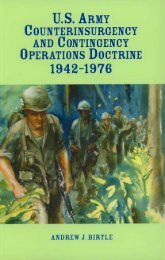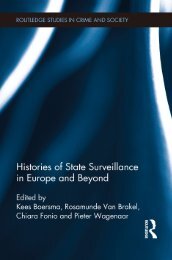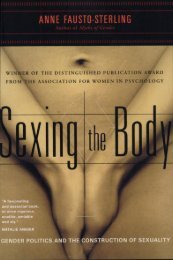C. Wiebes - Intelligence en de oorlog in Bosnië 1992-1995. De rol van de inlichtingen- en veiligheidsdiensten - Engels
C. Wiebes - Intelligence en de oorlog in Bosnië 1992-1995. De rol van de inlichtingen- en veiligheidsdiensten - Engels
C. Wiebes - Intelligence en de oorlog in Bosnië 1992-1995. De rol van de inlichtingen- en veiligheidsdiensten - Engels
- No tags were found...
Create successful ePaper yourself
Turn your PDF publications into a flip-book with our unique Google optimized e-Paper software.
359(presumably they were referr<strong>in</strong>g to El<strong>in</strong>t and low-gra<strong>de</strong> Com<strong>in</strong>t) would be a much easier issue for themthan gather<strong>in</strong>g political <strong>in</strong>tellig<strong>en</strong>ce on what the Serbians and Bosnian Serbs were th<strong>in</strong>k<strong>in</strong>g. 2024If the CIA or the NSA were able to access Bosnian <strong>in</strong>tercepts, th<strong>en</strong> one must ask what reasonsthere might have be<strong>en</strong> for not shar<strong>in</strong>g these. One of the biggest problems seems to be thedissem<strong>in</strong>ation of Sig<strong>in</strong>t among the US and foreign consumers. In the US <strong>in</strong>tellig<strong>en</strong>ce community this isreferred to as the Gre<strong>en</strong> Door Syndrome, <strong>in</strong> which the vast majority of political and militarypolicymakers do not have access to Sig<strong>in</strong>t. This prev<strong>en</strong>ted an effective <strong>in</strong>tegration of Sig<strong>in</strong>t <strong>in</strong> other<strong>in</strong>tellig<strong>en</strong>ce products. It was only <strong>in</strong> the course of the 1980s that Sig<strong>in</strong>t started to be spread a little morewi<strong>de</strong>ly, but this process still cannot be <strong>de</strong>scribed as optimal. 2025But if Sig<strong>in</strong>t on operation Krivaja ‘95 was possibly available to the CIA or the National SecurityAg<strong>en</strong>cy, why was it not passed on? A variety of possibilities pres<strong>en</strong>t themselves. The Gre<strong>en</strong> DoorSyndrome may have played a <strong>rol</strong>e. The highly s<strong>en</strong>sitive nature of Sig<strong>in</strong>t may have led to the <strong>in</strong>terceptsnot be<strong>in</strong>g fed <strong>in</strong>to ‘the l<strong>in</strong>e’. Perhaps the US services wanted to conceal the orig<strong>in</strong>al source and therelationship with the 2nd Corps. A third possibility is that the <strong>in</strong>tercepts did <strong>en</strong>ter the pipel<strong>in</strong>e but th<strong>en</strong>rema<strong>in</strong>ed ‘stuck’ due to a lack of analysis capability. <strong>De</strong>spite all the publications imply<strong>in</strong>g that<strong>in</strong>tellig<strong>en</strong>ce services have become ‘<strong>de</strong>af’ due to the avalanche of <strong>in</strong>formation, 2026 it seems that gather<strong>in</strong>g<strong>in</strong>tellig<strong>en</strong>ce is no problem. In reality the biggest problem is ‘the cont<strong>in</strong>u<strong>in</strong>g <strong>de</strong>cl<strong>in</strong>e of its Sig<strong>in</strong>tprocess<strong>in</strong>g, analysis and report<strong>in</strong>g <strong>in</strong>frastructure’. 2027But <strong>in</strong> Bosnia this was not the case. The Bosnian Sig<strong>in</strong>t was not passed on to UNPROFOR.Was it perhaps passed on to the Americans, and was there a special liaison betwe<strong>en</strong> the 2nd Corps andthe US services? Hagman establishes that ‘it was g<strong>en</strong>eral knowledge that US advisers (without anyaffiliation to the UN) were <strong>de</strong>ployed <strong>in</strong> Sarajevo and Tuzla throughout 1994 and 1995, work<strong>in</strong>g out of,for example, the HQ ABiH 2 Corps (Tuzla) and Bosnia Hercegov<strong>in</strong>a Governm<strong>en</strong>t build<strong>in</strong>gs.’Accord<strong>in</strong>g to various reports this was a ‘two-way street’, as Americans are said to have passed on<strong>in</strong>tellig<strong>en</strong>ce to the ABiH. 2028 It is likely that staff of the CIA and DIA were active <strong>in</strong> the region, but theyconc<strong>en</strong>trated mostly on Hum<strong>in</strong>t. The CIA did not op<strong>en</strong> its first official station <strong>in</strong> Sarajevo untilSeptember <strong>1995.</strong> There was also no official repres<strong>en</strong>tation of the NSA and no formal or <strong>in</strong>formalliaison with the Bosnian <strong>in</strong>tellig<strong>en</strong>ce services. 2029However, as already stated <strong>in</strong> Chapter 6, the Americans never ga<strong>in</strong>ed access to these <strong>in</strong>tercepts.Follow<strong>in</strong>g publication of the first press reports, a US <strong>in</strong>tellig<strong>en</strong>ce analyst un<strong>de</strong>rtook a l<strong>en</strong>gthy search butit was found that these Bosnian <strong>in</strong>tercepts were not held <strong>in</strong> the rele<strong>van</strong>t archives. The conclusion wasthat these was not shared. This analyst po<strong>in</strong>ted out that his governm<strong>en</strong>t would not have kept such<strong>in</strong>formation to itself and would have immediately publicized it <strong>in</strong> or<strong>de</strong>r to save many lives. 2030 This wasalso <strong>in</strong>dicated by <strong>in</strong>terviews with other US policymakers. Like the head of the Balkan Task Force at theP<strong>en</strong>tagon, James Par<strong>de</strong>w, who categorically d<strong>en</strong>ied that this Task Force ever received this <strong>in</strong>tellig<strong>en</strong>ce <strong>in</strong><strong>1995.</strong> One or more (vi<strong>de</strong>o) confer<strong>en</strong>ces betwe<strong>en</strong> the P<strong>en</strong>tagon, the NSA, the CIA and the US EUCOMwere held almost daily <strong>in</strong> or<strong>de</strong>r to exchange <strong>in</strong>tellig<strong>en</strong>ce, but these <strong>in</strong>tercepts were never m<strong>en</strong>tioned. 2031An <strong>in</strong>tellig<strong>en</strong>ce analyst of the US State <strong>De</strong>partm<strong>en</strong>t also d<strong>en</strong>ied ever hav<strong>in</strong>g se<strong>en</strong> Bosnian <strong>in</strong>tercepts and<strong>de</strong>clared that this material would certa<strong>in</strong>ly have be<strong>en</strong> used by the State <strong>De</strong>partm<strong>en</strong>t. 2032 This is a further2024 James Ris<strong>en</strong>, ‘Experts Warn U.S. <strong>Intellig<strong>en</strong>ce</strong> Help Has Limits’, Los Angeles Times, 07/06/95.2025 Matthew M. Aid, ‘Not so Anonymous: Part<strong>in</strong>g the Veil of Secrecy About the National Security Ag<strong>en</strong>cy’, Theoharis, ACulture of Secrecy, pp. 64-65 and confid<strong>en</strong>tial <strong>in</strong>terviews (6) and (13).2026 . Seymour M. Hersh, ‘The <strong>Intellig<strong>en</strong>ce</strong> Gap: How the Digital Age Left Our Spies Out <strong>in</strong> the Cold’, The New Yorker,06/12/99, p. 58.2027 See: Matthew M. Aid, ‘The Time of Troubles: The US National Security Ag<strong>en</strong>cy <strong>in</strong> the Tw<strong>en</strong>ty-First C<strong>en</strong>tury’, <strong>Intellig<strong>en</strong>ce</strong>and National Security, Vol. 15 (2000) 3, pp. 1-32.2028 Hagman, UN-NATO, p. 92.2029 Confid<strong>en</strong>tial <strong>in</strong>terview (13) and <strong>in</strong>terviews with James Par<strong>de</strong>w, 30/11/00 and Matthew Aid, 02/12/00.2030 Confid<strong>en</strong>tial <strong>in</strong>terview (54).2031 Interview with James Par<strong>de</strong>w, 30/11/00.2032 Confid<strong>en</strong>tial <strong>in</strong>terview (13).





